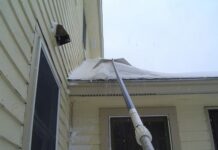By Carole Feldman
The early fall is a perfect time to start preparing for winter.
Many must-do projects, such as caulking, cleaning gutters, adding insulation or preparing emergency kits, will make your home more energy-efficient, help prevent weather damage and make things easier should the power go out.
“It is never too early to save energy and save money at home,” said Joelle Terry, spokesperson for the Energy Department. “Whether it’s choosing energy efficient products, sealing air and duct leaks, or adding insulation, American households could save over 20 percent on their household energy bills by making energy upgrades to their homes.”
To start, the department advises people to get an energy audit of their home, or do one themselves “to find out where you are losing energy — and money.”
Check with your utility company; some offer free or low-cost energy audits.
An energy audit can help determine if, for example, you have enough insulation, or whether there are leaks around windows or elsewhere that should be sealed.
Many winterizing projects, like caulking, can be done by the homeowner; others, such as checking the heating system, usually require a professional.
Here’s a look, alphabetically, at some things experts recommend doing to prepare for winter:
Air leaks
“Checking for any kind of air leaks is a prime project for this time of year,” said Kit Selzer, senior remodeling and projects editor at Better Homes and Gardens.
Caulk can be used to seal leaks around doors or windows, or around pipes or ductwork.
“Install foam gaskets behind outlet and switch plates on walls,” the Energy Department advises.
Weather-stripping can be placed at the bottom of a door or in a window sash to help produce a seal. There are many different types, from felt to vinyl and metal. A professional can advise what is best in each case.
Chimneys
Chimneys should be inspected and cleaned on a regular basis. “You want to make sure there’s nothing built up in the chimney or any debris that’s worked its way in,” Selzer said.
Why?
“Dirty chimneys can be a fire hazard,” the Chimney Safety Institute of America says on its website.
Creosote, a residue from wood burning, builds up over time and is combustible.
Make sure the damper is closed, except when using the fireplace.
Also, check to make sure a chimney cap is in place so birds or other wildlife don’t make the chimney their home.
Emergency kits
It’s good to have an emergency kit throughout the year, but it can be especially important in the middle of a snowstorm when the power goes out.
“When preparing for emergency situations, it’s best to think first about the basics of survival: fresh water, food, clean air and warmth,” the Federal Emergency Management Agency says.
In addition to these basics, the agency also recommends that emergency kits contain a battery-powered radio and flashlight, extra batteries, first aid items, moist towelettes and a whistle, among other items.
You also might want to have some ice melt on hand to treat icy sidewalks and driveways.
Fans
Ceiling fans circulate air in summer and winter. In winter, you’ll want to reverse the fan’s direction to eliminate downdraft. In most cases, you’ll want the fan to run clockwise during the winter months.
Gutters
“It’s a common thing for clogged gutters to freeze if they don’t drain properly,” said Pat Sandor, a “How To” expert at Home Depot. “Those can back up and cause damage to the home.”
So before winter, clean all debris from gutters and downspouts.
Selzer also advises looking for gaps in the gutter where water can drip through, freeze and cause icy patches.
Heating
Regardless of what type of heating system you use, it’s a good idea to have it checked before the start of each winter to make sure it is working correctly. “They’re checking filters, they’re checking connections,” Selzer said.
If you have oil heat, make sure your tank is full before the cold weather arrives.
Insulation
The Energy Department estimates that you can save up to 20 percent on heating and air conditioning bills by adding insulation to attics, under floors and in other areas where air can leak. There are several different kinds of insulation, ranging from batts or blanket insulation to loose fill or foams that can be sprayed in place. A department website, Energysavers.gov, has a map that shows how much insulation is needed in different areas of the country. An energy audit will be able to tell you if you have enough.
Selzer said that adding insulation is generally considered a do-it-yourself job. “A lot depends on how you can access your attic areas,” she said.
Sandor also recommended putting an insulation jacket on your water heater.
Outside faucets
Don’t forget to turn off water to the outside faucet and allow the faucet to drip dry before the below-freezing temperatures hit.
You can get a little hood, basically a hard plastic shell over foam, that you can put over the outside faucet to help prevent it from freezing, according to Sandor.
Windows
Winter is time to pull down those storm windows. If you don’t have any, a cheaper alternative to buying them is to put plastic sheeting over the window to try to block drafts.
Another easy way to make windows feel less drafty is insulated curtains, according to Selzer. — AP












